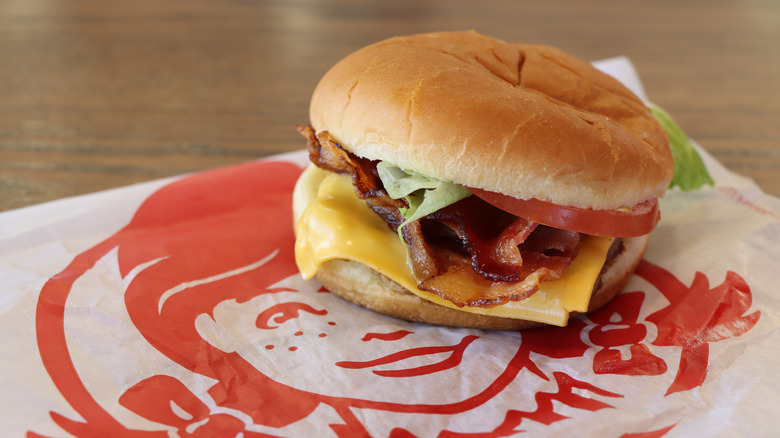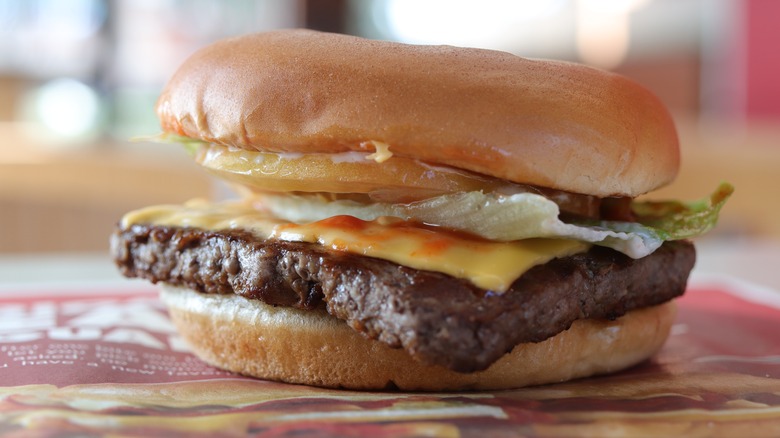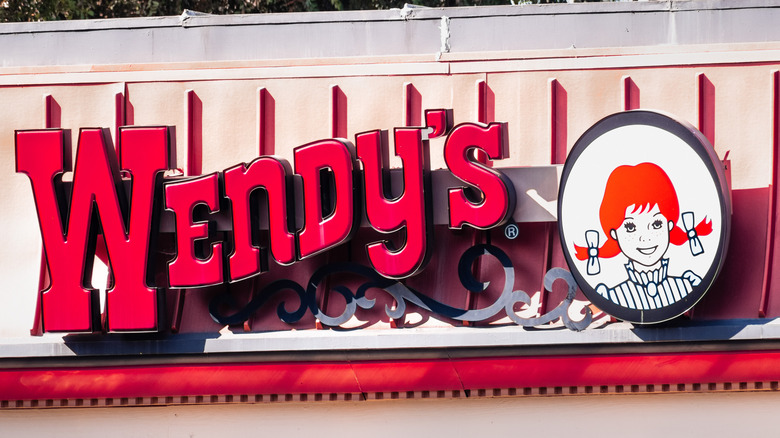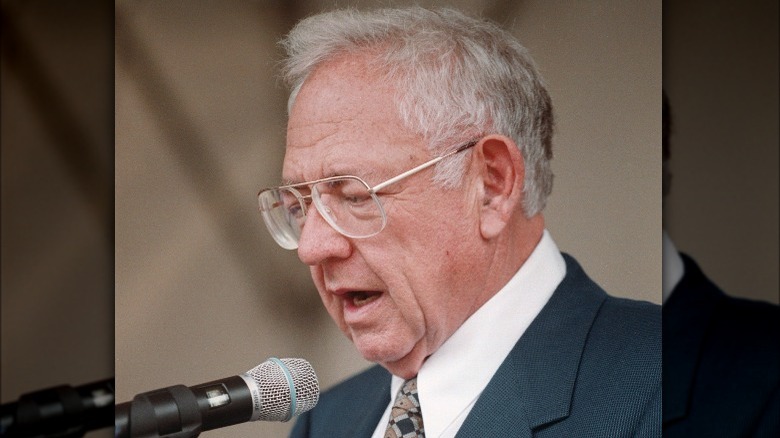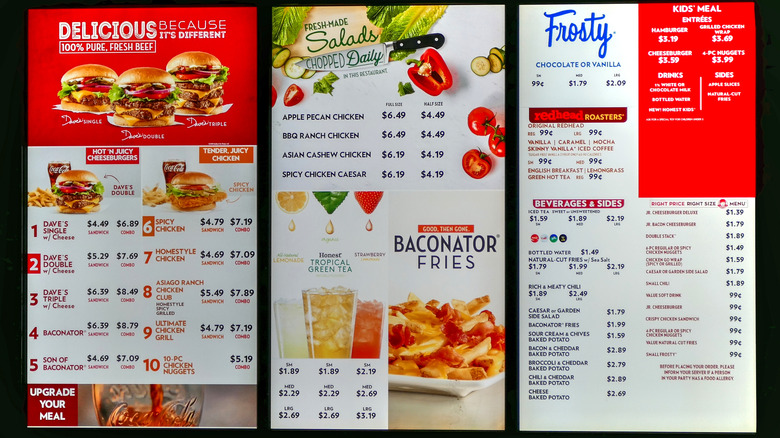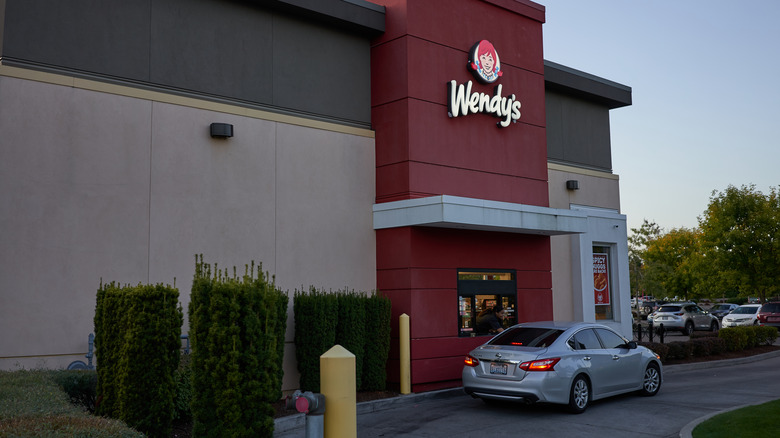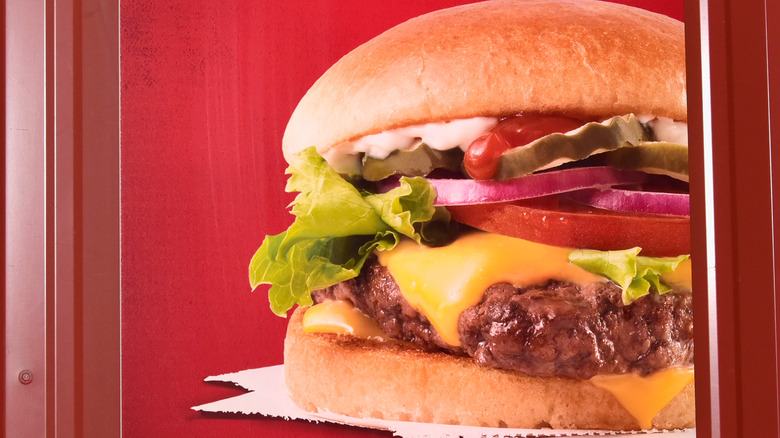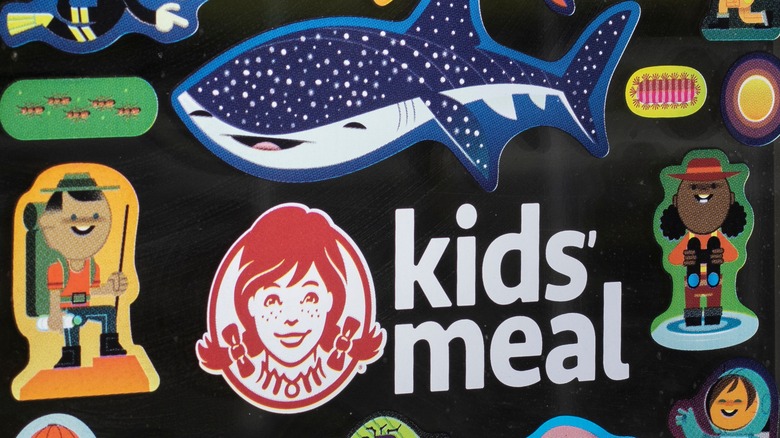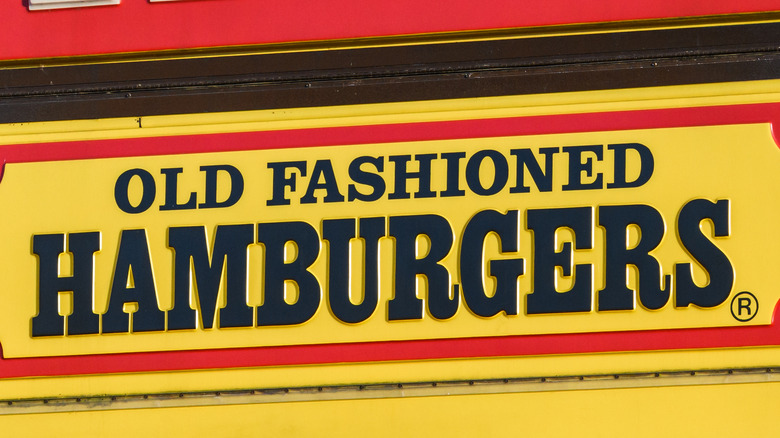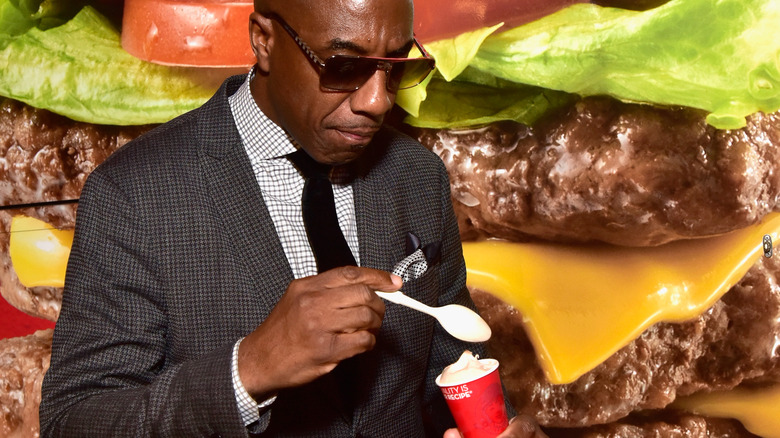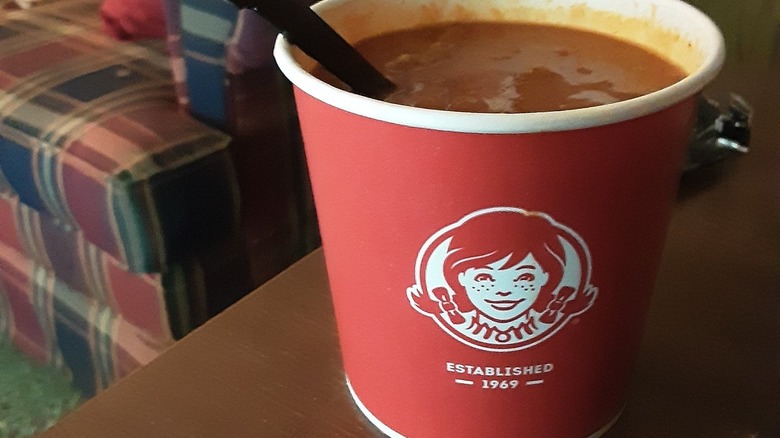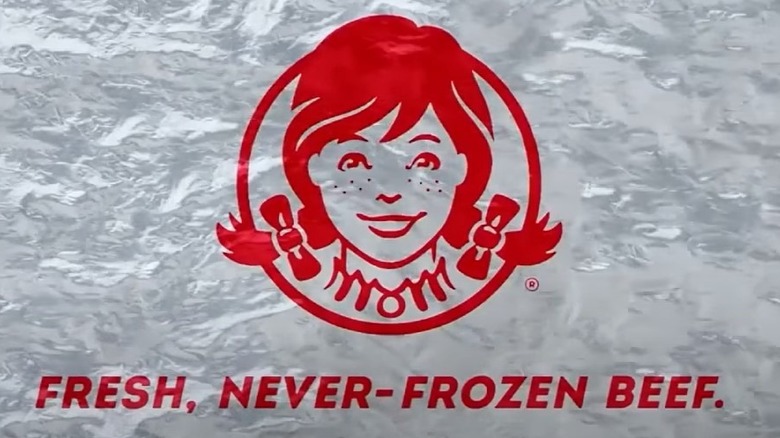What It Was Really Like To Eat At The First Wendy's
Is it possible for a fast food restaurant to surprise consumers in 2022? That's a tough nut to crack, particularly when you consider the virtually unlimited access to information and choices in modern society. Either way, blowing customers away in a fast food setting is far more challenging today than it was in 1969 when Dave Thomas opened the very first Wendy's restaurant in Columbus, Ohio (via Wendy's).
A man who was never shy about appearing in his own commercials, Thomas was set up for success when he first opened his restaurant's doors. He was already a veteran of the industry by that time, having turned around several KFC franchises in Ohio during the 1960s (although Colonel Sanders himself wasn't exactly a fan of his precise methods).
While very few entirely original fast food ideas are left to plunder in 2022, that clearly wasn't the case when the first Wendy's opened. But what was that experience like? How did dining at the original Wendy's differ from a visit to a location in the 21st century? Well, as always, we've got you covered here at Mashed. So if you're curious like a cat about Dave Thomas' first restaurant — whether or not your friends call you Whiskers — wonder no more, as we reveal what it was really like to eat at the first Wendy's.
The square hamburgers were an odd sight to see for customers
Have you ever noticed how many square hamburger rolls are for sale at the store? Of course not. They don't exist, because everyone knows burgers are round — with the notable exception of Wendy's old-fashioned hamburgers, that is. The fast food chain's burger style is ingrained in the brains of modern consumers, with its four corners spilling over the bun's round edges. But back when Dave Thomas first sold his square-shaped beef patties to the public, the design was unique enough to grab new customers' attention (via Wendy's).
Of course, it wasn't just the shape of its burgers that led folks to patronize the first Wendy's. But Thomas' choice did allow the restaurant to stand out from the quick-service crowd. Additionally, the choice to prepare square burgers ensured its customers knew the burgers were handmade from fresh beef (via CNN). After all, conventional wisdom would suggest the burgers couldn't be pre-processed or previously frozen if they weren't round.
The aesthetic choice wasn't just about leaving a visual impression, though (or to demonstrate the restaurant would never cut corners with its food). As Wendy's vice president of culinary innovation, John Li, told CNN in 2022, its cooks "can fit more square hamburgers on a single grill than round ones" — making the square burgers a savvy business move in more ways than one.
The decor made it drastically different from other fast food restaurants
Fast food burger restaurants weren't nearly as ubiquitous in 1969 as they are in the 2020s. But the marketplace was still fairly crowded when Dave Thomas threw his hat into the ring with Wendy's. Not that he was interested in creating a carbon copy of other successful chains at the time. In fact, having essentially devised Wendy's as the antithesis of what people had come to expect from fast food establishments, Thomas furnished the restaurant with higher-end decor — hoping to reflect the higher-quality experience Wendy's would offer (via CNN).
Diners at the first Wendy's were undoubtedly treated to a quick-service burger joint unlike any other. In a marked contrast from the plastic-molded booths and easy-to-sanitize surfaces found at similar restaurants (via Funding Universe), Wendy's was carpeted and featured Tiffany lamps, hanging beads, and bentwood chairs for guests to sit on.
Additionally, employees wore all-white uniforms (with the exception of a black bowtie required for male staff), as well as white aprons. This, as Thomas wrote in his autobiography, "Dave's Way" (via CNN), was to present a "feel of cleanliness and tradition" to each and every customer while dining.
You might have run into Dave Thomas while eating there
There's no one right way for a person to run a business. Frankly, if you were to ask 100 different people what a successful business owner looks like, there's a good chance you'd receive 100 different answers. Some may prefer to delegate and take a laissez-faire approach; others can't help but be intimately involved with every aspect of their business. By all accounts, the hands-on Dave Thomas belonged in the latter group (via Columbus Monthly), meaning if you ate at his first Wendy's location, there was a good chance you'd have seen him inside.
Ever since he first started working professionally at the age of 12 (via Wendy's), Thomas possessed a powerful work ethic. According to the company, his grandmother, Minnie, had taught him the value of hard work, so he was unfazed by the grueling effort required by the food service industry. Additionally, having already revived four KFC restaurants in Ohio before opening Wendy's, he was more than familiar with the difficulties of running a successful restaurant.
Honestly, this may be the least surprising revelation to modern diners regarding the first Wendy's. After all, since Thomas only owned one restaurant when he first opened Wendy's, where else would the man have been?
The selection was drastically limited compared to 2022
The plethora of available options on modern fast food menus is enough to make your head spin. Of course, the often-overwhelming assortment of choices wouldn't have been an issue for anyone eating at the first Wendy's, which had a very simple menu when it opened. In fact, the first Wendy's menu consisted solely of burgers, fries, chili, soda, and Frosty frozen dairy desserts (via Wendy's).
If you're wondering why the original menu lacked some of your modern-day favorites — like the Baconator or Spicy Chicken Sandwich — it isn't exactly some deep mystery. Considering that around 60% of restaurants fail within the first year of opening (via CNBC), Thomas likely believed that serving a few extremely well-made items (rather than a surplus of mediocre ones) would decrease the odds of early closure. And since he was firmly committed to the use of fresh, higher-quality (but more expensive) ingredients, fewer menu items meant less food to buy upfront — therefore lowering those business expenses and freeing money to spend in other areas.
Thomas had actually already achieved great success with a simplified menu before opening his own restaurant, as well. After all, according to Wendy's, his decision to cut down the available menu options at several previously-failing KFC restaurants during the 1960s was one of the biggest factors in each location's renewed good fortune.
You wouldn't have had a drive-thru pick-up window at first
It's sort of startling to even consider a world without drive-thru dining — particularly after the emergence of COVID-19 amplified the general public's desire to decrease time spent around strangers. But any introverts looking to patronize the first Wendy's without leaving their cars would have been out of luck, as the original restaurant didn't have a drive-thru window when it first opened in 1969 (via Wendy's).
While the first restaurant opened by Dave Thomas didn't have a drive-thru (or pick-up window, as the company described it), there was good news on the horizon for any customers seeking one out. When Thomas expanded his business and opened the first freestanding location in 1970, that restaurant was able to incorporate a pick-up window to boost business — and it never looked back.
Wendy's wasn't the very first business to utilize an outside serving window to accommodate diners on the go. But since there's no denying the widespread implementation of drive-thru essentially revolutionized the industry (via History), it's clear that early adoption of the concept was just one more example of Dave Thomas' genius.
Wendy's was the only place to get a good burger in Columbus, according to Dave Thomas
There's hardly a universal consensus when it comes to what makes a delicious burger. That's to be expected, of course, given the monumental variation in each individual's tastes, as well as the varying flavor preferences found in different cultures or regions. Yet the utilization of fresh ingredients of impeccable quality can elevate any burger into a succulent, savory celebration of beef. Dave Thomas recognized this, but didn't feel any restaurants in Columbus, Ohio met his high personal bar for a truly delicious burger during the 1960s — so he opened Wendy's to fill that void (via Biography).
Thomas was a man relentlessly driven to give the world what he craved. And he wasn't the only one who felt the burger market was less than enticing before the first Wendy's entered the fray. In fact, when a friend of his mentioned the downtown Columbus area was lacking in worthwhile lunch spots, it spurred Thomas onward in his pursuit to sell the best burger possible (via Wendy's). Thomas certainly achieved his goal, and, soon enough, any complaints that an exceptional burger was unavailable in the Ohio city went by the wayside.
There may have been far fewer children dining than in other fast food restaurants
As exhausted parents around the U.S. are painfully aware, fast food advertisements aimed at children are impossible to avoid. From playful, kid-friendly mascots to kid's meals with toys included, it's clear that fast food companies often shape marketing campaigns around what kids want. Wendy's may be no different than its competitors in 2022, but when Dave Thomas opened the first Wendy's in 1969, he was more interested in courting young adults with money to spare than kids eager for a treat (via CNN).
Since Wendy's was more expensive than other burger restaurants at the time (via RoadsideAmerica.com), it couldn't rely on cash-strapped parents looking for a cheap, quick meal for their children. But it wasn't necessarily interested in specifically courting those customers, either. Thomas believed he could convince Baby Boomers flush with additional cash during their first decades of adulthood to patronize his restaurant. He hoped that the demographic would be both willing and able to pay more to eat his superior product.
Children weren't persona non grata at the first Wendy's by any means. But compared to McDonald's or Burger King (or even Wendy's in 2022), the original Wendy's clientele was more likely to consist of young, well-groomed professionals rather than sticky-fingered kids running rampant.
The burgers were known as old-fashioned even then
When a company describes a product as old-fashioned, it's not necessarily meant to convey its product is authentically old school. The phrase is designed to evoke a feeling of nostalgia within potential customers, stirring a desire for the past in consumers that will then translate into sales. This seems to be the precise thought process for Dave Thomas when he founded Wendy's, which was called Wendy's Old-Fashioned Hamburgers when it first opened (via CNN).
Actually, when you consider the evolution of food preservation, the idea that the first Wendy's did, in fact, serve old-fashioned burgers has a ring of truth. After all, the widespread use and sale of frozen foods didn't truly blossom until the 1940s and '50s (via Supermarket News). In other words, just like those served in his restaurant in 1969, the burgers Dave Thomas consumed as a child in the 1930s were never frozen, either, so the old-fashioned tagline may have been more accurate than we initially assumed.
The frosty was a unique frozen treat dreamed up by an ice cream machine manufacturer
To be honest, when it comes to the definition of a Frosty, we're not exactly sure what to call it. But whether it's straight-up ice cream, or a milkshake, or some amalgamation of the two, there's no doubting that the Frosty is one of Dave Thomas' more iconic creations. Luckily for customers at the first Wendy's, the Frosty was available from day one (via Wendy's).
According to Wendy's, the famed Frosty was the brainchild of Fred Kappus, the owner of a local foodservice equipment distributor. Thomas contacted Kappus before launching the first Wendy's, hoping the purveyor of ice cream machines would have an idea for a sweet frozen treat to sell. Using the not-so-secret concept of mixing a little bit of vanilla ice cream with chocolate to increase the maltiness, the Frosty was soon born.
Unsurprisingly, the locally-produced, soft serve-adjacent Frosty was a hit with customers. More than 50 years later, it's still a fan favorite — though who'd have ever thought it would become one of the best dipping condiments for fries?
Wendy's was more expensive than the competition
Since affordability is one of the main appeals of fast food, we don't usually expect fast food items to be as expensive as those sold by more upscale establishments. But Dave Thomas' goal when first opening Wendy's was to replicate those higher-end businesses, rather than mimicking the cheaper burger chains already in existence. Consequently, the premium products sold at the first Wendy's — made with better quality and, therefore, pricier ingredients — cost more than the average quick-service burger joint in the late 1960s (via RoadsideAmerica.com).
Diners at the first Wendy's were likely unsure about paying a pretty penny for a burger and fries, at least initially. But confident any customer apprehension would be negated once they took that first bite of his restaurant's hot 'n juicy burger, Thomas did what he had to do. Clearly, the pricing gambit worked, and within 10 years of first opening, there were more than 1,000 Wendy's locations across the U.S. (via Wendy's).
No matter what the classic song says, the best things in life are decidedly not free. In fact, we'd say some of the best (and highest quality) things in life are consistently costlier than many would prefer. If the product is actually superior to cheaper options, though, the extra cost can be worth it. Just ask Dave Thomas.
The chili has been on the menu since day one
Since its inception, Wendy's has never been interested in simply doing what's expected and has thrived by operating as a square (hamburger) peg in a round hole. While most fast food burger chains are satisfied with fries, for instance, the Wendy's menu offers wholly unique choices like baked potatoes and chili. Customers eating at the very first Wendy's couldn't enjoy a baked potato, unfortunately — but they could grab themselves a cup of hot, fresh chili (via Wendy's).
As founder Dave Thomas noted in his autobiography, "Dave's Way," the concept of serving chili was obvious, as it allowed him to recycle the leftover hamburger without wasting it. While the decision was clear, the specific recipe was harder to pin down, according to Thomas. Not that creating a palatable chili was out of reach for a man who would come to create some of the most iconic food products the world has ever seen.
It's easy to imagine that customers eating Wendy's chili at the first restaurant weren't sure what to expect. After all, a fast food burger restaurant with chili as a staple menu item is somewhat rare. But like everything else Dave Thomas ever cooked and served, any concerns about Wendy's chili were quickly forgotten after consuming it.
You could enjoy never-frozen, freshly-made burgers from the start
Is it possible that anyone who's lived in the U.S. over the past half-century is unaware that Wendy's beef is always fresh and never frozen? We'd guess not. But unlike consumers who've experienced 50-plus years of Wendy's as an American institution, diners at the very first Wendy's weren't yet accustomed to the chain's preferred practices. Since Wendy's has served fresh beef since day one, though, that meant customers at the first location could enjoy made-to-order burgers that weren't previously frozen or prepared (via Columbus Monthly).
According to Wendy's, Thomas believed a burger made with entirely fresh ingredients led to a product worthy of the old-fashioned moniker. Considering the mind-boggling growth and expansion of Wendy's after the first location opened in 1969 (with more than 1,000 restaurants opened before the end of the 1970s), it seems like customers agreed with Thomas' assessment, too.
The use of fresh, never-frozen beef has become a cornerstone of the Wendy's brand. After all, the company's ability to consistently deliver fresh, square beef is what consumers love and expect, as Vice President of Culinary Innovation John Li told CNN in 2022.
